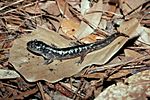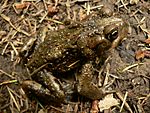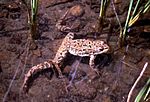List of amphibians of Yellowstone National Park facts for kids
Yellowstone National Park is a huge and amazing place, full of all sorts of wildlife! Among its many creatures are amphibians – cool animals like frogs, toads, and salamanders. These special animals can live both in water and on land. This article will introduce you to the amphibians you might find living in Yellowstone.
Blotched Tiger Salamander
The Blotched tiger salamander (Ambystoma tigrinum melanostictum) is a type of Mole salamander. Tiger salamanders are quite large. They usually grow to be about 6–8 in (150–200 mm) long. Some can even reach up to 14 in (36 cm)! These larger ones are often "neotenic," meaning they keep some of their young features, like gills, even as adults.
Adult salamanders often have blotchy patterns of grey, green, or black. They have big eyes with eyelids, short snouts, thick necks, strong legs, and long tails. They mostly eat small insects and worms. But sometimes, an adult might even eat small frogs or baby mice!
In Yellowstone, the Blotched tiger salamander is the only type of salamander you'll find. It lives in many different places across the park. You can find large groups of them in areas like Lamar Valley. These salamanders breed in ponds and lakes that don't have fish.
Boreal Chorus Frog
The Boreal chorus frog (Pseudacris maculata) is a small frog. It is found in Canada and parts of the United States, including Montana. This frog is only about 30mm long. It can be brown or green on its back. It often has three broken stripes on its back, which can be very clear or quite faint.
There is also a dark stripe that goes from its nose, through its eye, and down its side. This frog has slightly bigger toe pads. These help it climb small plants and grasses.
In Yellowstone, this frog is common. However, it's hard to spot because it's so small and likes to hide. It lives in wet meadows and forests near watery areas. It lays its eggs in loose groups. These eggs are attached to plants that are underwater in calm water.
Western Toad
The Western toad (Bufo boreas) is a large toad. It can grow to be between 5.6 and 13 cm long. It lives in western North America. This toad has a white or cream stripe down its back. Its skin is usually dusky grey or greenish. It has skin glands grouped in dark blotches. This is the only toad species found in Yellowstone.
This toad used to be common throughout the park. But now, it seems much rarer than spotted frogs and chorus frogs. Scientists are worried that this species has become less common in the Greater Yellowstone area. Adult toads can travel far from water. This is because they can soak up water from tiny puddles or damp spots. They lay their eggs in shallow, warm water. This includes ponds, lake edges, slow streams, and quiet river areas.
Columbia Spotted Frog
The Columbia spotted frog (Rana luteiventris) is a North American frog species. It is a medium-sized frog. It can grow up to three and a half inches (8.9 cm) long. Its color can be dark olive green to light brown. It has black spots that are not perfectly shaped on its back and legs. Its belly and upper lip are white.
You can tell this frog apart from other Rana frogs by its shorter back legs, narrow snout, and eyes that point upwards. Since these frogs spend most of their time in the water, they also have more webbing between their back toes than similar frog species.
In Yellowstone, this frog is very common. It is the best-known amphibian in the park. You can find it all summer long in or near rivers, streams, smaller lakes, marshes, ponds, and even rain puddles. It lays its eggs in still or quiet water. The eggs are in round masses surrounded by a jelly-like substance.
- Amphibians of Yellowstone National Park
See also





